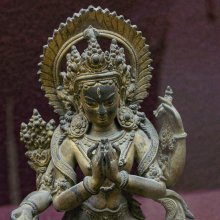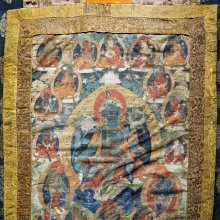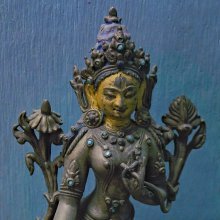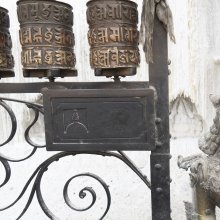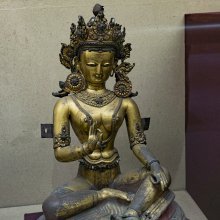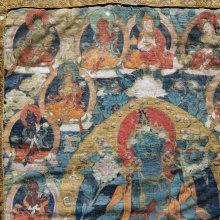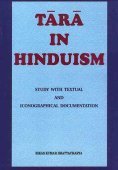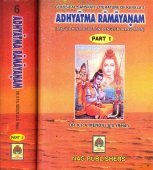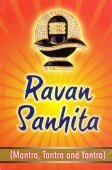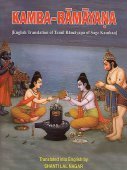Tara, Tārā, Tāra: 61 definitions
Introduction:
Tara means something in Buddhism, Pali, Hinduism, Sanskrit, Jainism, Prakrit, the history of ancient India, Marathi, Hindi, biology, Tamil. If you want to know the exact meaning, history, etymology or English translation of this term then check out the descriptions on this page. Add your comment or reference to a book if you want to contribute to this summary article.
Alternative spellings of this word include Taar.
Images (photo gallery)
(+153 more images available)
In Hinduism
Purana and Itihasa (epic history)
Source: Wisdom Library: Bhagavata PuranaTārā (तारा):—She is the wife of Bṛhaspati. She was kidnapped by Soma, the moon-god. Soma (the moon-god) and Tārā begat a son called Budha. (see Bhāgavata Purāṇa 9.14.3-14)
Source: archive.org: Puranic Encyclopedia1) Tāra (तार).—A monkey who was a devotee of Śrī Rāma. This big monkey was the son of Bṛhaspati. Bṛhaspati made this monkey greater in size and intellect than all other monkeys. This Tāra was the minister of Bāli. (Śloka 10, Sarga 17, Bāla Kāṇḍa, Vālmīki Rāmāyaṇa and Uttara Rāmāyaṇa). In the Rāma-Rāvaṇa battle this monkey fought against the demon Nikharvaṭa. (Śloka 9, Chapter 285, Vana Parva).
2) Tārā (तारा).—Wife of Bāli, best of Vānaras (monkeys). There are two stories different from each other regarding the birth of Tārā. One version is that Tārā was born during the churning of the Milk-Ocean. Airāvata, Uccaiśśravas, Kalpavṛkṣa, Cintāmaṇi, Kaustubha, Candra, Apsarases, Mahālakṣmī Tārā and Rumā rose from the sea of Milk. (Yuddha Kāṇḍa, Kamba Rāmāyaṇa). The second version is that Tārā was the daughter of Suṣeṇa. Bāli at the time of his death is said to have spoken thus of his wife Tārā "Tārā, daughter of Suṣeṇa, is well learned and is capable of assessing a situation and suggesting the correct thing to be done at that time. If she says a thing is good, it is never otherwise." (Chapter 22, Kiṣkindhā Kāṇḍa, Vālmīki Rāmāyaṇa). From this it can be understood that Tārā was the daughter of Suṣeṇa and we get an idea of the character of Tārā also from this. (See under Bāli).
3) Tārā (तारा).—Wife of Bṛhaspati. She was extremely beautiful. Once she fell in love with Candra (Moon) and leaving her husband started living with him. Candra was the disciple of Bṛhaspati. The devas were angry when they found the wife of their preceptor staying with a disciple of his. Bṛhaspati sent word to her to return home but she did not heed. At last the Devas decided to fight against Candra. Then they came to a compromise and Tārā was sent back to Bṛhaspati. In due course Tārā delivered a son. He was Budha, father of Purūravas. There arose then a dispute between Candra and Bṛhaspati regarding the fatherhood of the child. Then the Devas called Tārā and asked her to name the child’s father. Tārā said that the child was of Candra and so Budha was looked after at the house of Candra. (9th Skandha, Bhāgavata).
Source: archive.org: Shiva Purana - English TranslationTāra (तार, “star”) is the name of a deity, according the Śivapurāṇa 2.2.41.—Accordingly, as Viṣṇu and others eulogized Śiva:—“[...] obeisance to Tāra (star), Sutāra (one that enables others to cross), Taruṇa (the ever young), and the brilliant. Obeisance to Śiva who is beneficent to the gods, the lord, the great soul, Obeisance to you the great; obeisance to you, the dark-necked God”.
Source: Cologne Digital Sanskrit Dictionaries: The Purana Index1a) Tāra (तार).—A monkey chief.*
- * Brahmāṇḍa-purāṇa III. 7. 231.
1b) A God of the Harita gaṇa.*
- * Brahmāṇḍa-purāṇa IV. 1. 85.
2a) Tārā (तारा).—The wife of Bṛhaspati, and abducted by Soma. Of this union was born Budha. Through Brahmā's influence she was restored to her husband; (came back to Bṛhaspati after a battle between the Devas and the Dānavas).*
- * Bhāgavata-purāṇa IX. 14. 4-8, 13-14; Brahmāṇḍa-purāṇa III. 65. 29; Matsya-purāṇa 23. 30-47; 24. 3; Vāyu-purāṇa 90. 28-35, 43. Viṣṇu-purāṇa IV. 6. 10-33.
2b) A Brahmavādinī.*
- * Brahmāṇḍa-purāṇa II. 33. 18.
2c) A daughter of Suṣeṇa and queen of Vāli; her son was Aṅgada.*
- * Brahmāṇḍa-purāṇa III. 7. 219.
2d) Also Toraṇeśvari and Tārāmbikā; a Śakti living in the midst of waters that could be crossed only by boats of different sizes.*
- * Brahmāṇḍa-purāṇa IV. 35. 12-24, 58; 36. 16; 44. 80.
2e) The goddess enshrined at Kiṣkindhaparvata.*
- * Matsya-purāṇa 13. 46.
2f) One of the ten branches of the Harita group of Devas.*
- * Vāyu-purāṇa 100. 89.
Tāra (तार) refers to one of the sons of Bāṇa or Bāṇāsura: the son of Bali, according to one account of Vaṃśa (‘genealogical description’) of the 10th century Saurapurāṇa: one of the various Upapurāṇas depicting Śaivism.—Accordingly, Prahlāda’s son was Virocana who was killed by Viṣṇu and his son Bali became the king. He was pious and virtuous and was bound to Pātalā by Viṣṇu. Bāṇāsura was the son of Bali, who was a devotee of Śiva. The Lord gave Bāṇāsura the status of the leader of a Gaṇa. The son’s of Bāṇa were [viz., Tāra].

The Purana (पुराण, purāṇas) refers to Sanskrit literature preserving ancient India’s vast cultural history, including historical legends, religious ceremonies, various arts and sciences. The eighteen mahapuranas total over 400,000 shlokas (metrical couplets) and date to at least several centuries BCE.
Shaktism (Shakta philosophy)
Source: Wisdom Library: ŚāktismTārā (तारा, “star”):—The second of the ten Mahāvidyās. She represents the cosmic power of consumption. The human absolute need for food resembles the cosmic force of hunger. The ten Mahāvidyās are the emanations of Mahākālī, the Goddess of time and death. She is depicted as a fearful laughing goddess with four arms entwined with poisonous snakes in her hair. She has three red eyes, a wagging tongue and feaful teeth. Her left foot is standing on a corpse
Source: Google Books: Manthanabhairavatantram1) Tārā (तारा) refers to the Goddess (Śakti) (of the first of seven births before attaining liberation) according to the Janmasūtra.—The six beginning with the Buddhists and ending with the Śaivites are in the fettered state (paśubhāva). The seventh that has come into being is the House (veśman) of the Yoginī whose sign is liberation. In the first one Tārā is the goddess (śakti) and Ambikā in the second. Gāyatrī is (the form of the goddess) in the third (birth) and Lakṣmī in the fourth. In the fifth she is Rājñī and is said to be Umā in the sixth. In the seventh she is Khañjī who has descended in each Age.
2) Tāra (तार) refers to one of the male servants associated with Kāmarūpa, one of the sacred seats (pīṭha), according to the Manthānabhairavatantra, a vast sprawling work that belongs to a corpus of Tantric texts concerned with the worship of the goddess Kubjikā.—Nine of the twelve female servants (three in each of the first four seats), are low-caste women who we find, in other contexts, embody the Mothers (mātṛkā). The maids (cellakā) are Yoginīs and the servants their male counterparts [i.e., Tāra]. These replace the spiritual ‘sons’ and ‘daughters’ the goddess generates and the guardians she appoints in the sacred seats listed in the ‘Kubjikāmatatantra’.
3) Tārā (तारा) refers to one of the thirty-two Bhairavīs (also Dūtis) embodying the syllables of the goddess’s Vidyā, according to the Manthānabhairavatantra.—The thirty-two Bhairavīs [i.e., Tārā] are the consorts of the Bhairavas presiding over the sonic energies of the thirty-two syllables of her Vidyā.
Source: Red Zambala: The 10 Great Wisdom GoddessesThe Star (Tārā) is the first force that arises in the Bindu [Golden-Embryo — Hiraṇya-garbha], the cosmic location from which the universe evolves. The nature of the Golden Embryo can well be said to be hunger and its power lies in the ability to devour. The name given to this pure and absolute, hunger is — “the Star” (Tārā).
Although the word Tārā means a star, the Tantras take its etymology to mean “that which leads to the other shore.” “She who brings us to the other shore (Tārāti) is Tārā.”
Just as the nature of hunger is twofold - ravenous, all-consuming, driving, forcing before consumption, and the other pacified, peaceful and contented after consumption —Tārā also is depicted in a dual aspect, the one fierce, fearful, all-devouring, the other pacified and luminous. This is duality is also the nature of the sun and of all beings.
Source: Sacred Texts: Hymns to the GoddessTārā (तारा) or Tāriṇī is the name of a Mahāvidyā.—The Matsyasūkta, Tārārṇava, and Nīla Tantras deal with particulars or Tārā or Tāriṇī, one of the Mahāvidyā, whose bīja is Hrīm Strīm, Hūm (Kurccha), Phat. She is called Nīlasarasvatī, because She playfully gives the power of speech. She is called Tārā on account of her being deliverer or saviour (tārakatvāt). She gives both pleasure (sukha) and liberation (mokṣa). She is called also Ugratārā, because She saves from formidable and horrible calamities. Ṛṣi Vasiṣṭha [Vaśiṣṭha] is said to have cursed this vidyā, and then raised the curse so that siddhi might be gained from Her by japa of the Bīja Hrīm, Strīm, Hūm, Phat, after which She again became glorious.
Source: Brill: Śaivism and the Tantric Traditions (shaktism)Tāra (तार) or Tārabīja refers to the “tāra-syllable”; (Tāra is a common code word for the syllable oṃ), according to Sāhib Kaul’s Śārikāstrotra.—Accordingly, “With true devotion I worship that divine and omnipresent Śārikā, who bears the crescent moon on her head, who grants liberation, destroys delusion everywhere, destroys the bad fear of meeting a wrong death. O mother Śārikā, whoever devotedly recites your tāra-syllable [i.e., tārabīja—tāraṃ bījaṇ], which carries one across the ocean of transmigration, may, when his wisdom is ripened through the knowledge of the absolute, even put to shame the Lord of the Word. [...]”.

Shakta (शाक्त, śākta) or Shaktism (śāktism) represents a tradition of Hinduism where the Goddess (Devi) is revered and worshipped. Shakta literature includes a range of scriptures, including various Agamas and Tantras, although its roots may be traced back to the Vedas.
Vaishnavism (Vaishava dharma)
Source: ISKCON Press: GlossaryTārā (तारा).—The wife of Bṛhaspati. She was kidnapped by the moon-god.

Vaishnava (वैष्णव, vaiṣṇava) or vaishnavism (vaiṣṇavism) represents a tradition of Hinduism worshipping Vishnu as the supreme Lord. Similar to the Shaktism and Shaivism traditions, Vaishnavism also developed as an individual movement, famous for its exposition of the dashavatara (‘ten avatars of Vishnu’).
Natyashastra (theatrics and dramaturgy)
Source: Wisdom Library: Nāṭya-śāstra1) Tārā (तारा) refers to the “eyeballs”. It is one of the parts of the human body with which gestures (āṅgika) are performaned, according to the Nāṭyaśāstra chapter 8. These nine movements of the eyeballs (tārā) are followed by the corresponding nine gestures of the eyeballs (puṭa). These gestures form a part of the histrionic representation (abhinaya).
There are nine kinds of gestures defined for the eyeballs (tārā):
- bhramaṇa (moving round),
- valana (turning),
- pāta, pātana (relaxing),
- calana (trembling),
- saṃpraveśana (drawing inside),
- vivartana (turning sideways),
- samudvṛtta (raising up),
- niṣkrama (going out),
- prākṛta (natural).
2) Tāra (तार, “high”) refers to “high pitches” and is one of the ten characteristics (gati) of the jāti (melodic class), according to the Nāṭyaśāstra chapter 28. It is also known as tāragati or tārasvara. Jāti refers to a recognized melody-type and can be seen as a precursor to rāgas which replaced them.
According to the Nāṭyaśāstra 28.93-94, “the high pitch movement (tāra-gati) depending on the first five notes, e.g., The raising of the pitch from the any of the aṃśa notes (svara) should be up to the note fourth from it, or it may be to the fifth note even, but not to any beyond it”.
Source: Shodhganga: The significance of the mūla-beras (natya)Tāra (तार, “pupils”) refers to one of the twelve “subsidiary limbs” (upāṅga), which represents a division of Āṅgikābhinaya (gesture language of the limbs) as used within the classical tradition of Indian dance and performance, also known as Bharatanatyam.—Āṅgika-abhinaya is the gesture language of the limbs. Dance is an art that expresses itself through the medium of body, and therefore, āṅgikābhinaya is essential for any dance and especially for any classical dance of India. Upāṅgas or the subsidiary limbs consist of the eyes, the eye-brows, pupils [viz., Tāra], cheeks, nose, jaws, lips, teeth, tongue, chin, face, and the head.

Natyashastra (नाट्यशास्त्र, nāṭyaśāstra) refers to both the ancient Indian tradition (shastra) of performing arts, (natya—theatrics, drama, dance, music), as well as the name of a Sanskrit work dealing with these subjects. It also teaches the rules for composing Dramatic plays (nataka), construction and performance of Theater, and Poetic works (kavya).
Shilpashastra (iconography)
Source: archive.org: Illustrations of Indian Music and Dance in Western Indian StyleTāra (तार, “high”).—Illustration of tāra-grāma (highest group of tones) according to 15th century art.—The colour of the body of tāra-grāma is light-red. He holds a vīṇā (Indian lute) with both hands. The colour of the scarf is blue with a red design and the lower garment is yellow with a black design. He is well-dressed and his ears, throat and the head are well ornamented.
The illustrations (of, for example Tāra) are found scattered throughout ancient Jain manuscripts from Gujarat. The descriptions of these illustrations of this citrāvalī are based on the ślokas of Vācanācārya Gaṇi Sudhākalaśa’s Saṅgītopaniṣatsāroddhāra (14th century) and Śārṅgadeva’s Saṅgītaratnākara (13th century).
Source: Shodhganga: Elements of Art and Architecture in the Trtiyakhanda of the Visnudharmottarapurana (shilpa)Tārā (तारा) or “eye-ball” refers to one of the various body parts whose Measurements should follow the principles of ancient Indian Painting (citra), according to the Viṣṇudharmottarapurāṇa, an ancient Sanskrit text which (being encyclopedic in nature) deals with a variety of cultural topics such as arts, architecture, music, grammar and astronomy.—In the Viṣṇudharmottarapurāṇa, a specific measurement of every limb of a man as well as of a woman is elaborately and systematically discussed. In this book, the writer has presented the measurement of almost all the body parts that should be maintained in a picture. For example, Tārā (“eye-ball”) should be 1/5th aṅgulas.
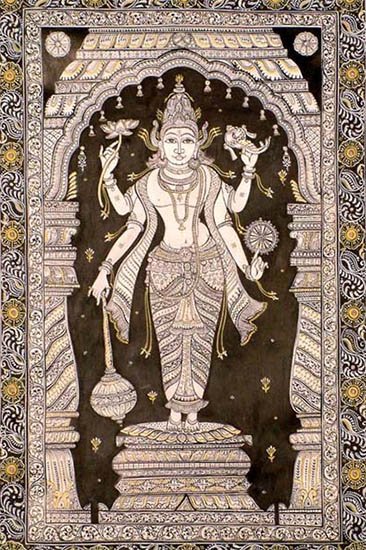
Shilpashastra (शिल्पशास्त्र, śilpaśāstra) represents the ancient Indian science (shastra) of creative arts (shilpa) such as sculpture, iconography and painting. Closely related to Vastushastra (architecture), they often share the same literature.
Vyakarana (Sanskrit grammar)
Source: Wikisource: A dictionary of Sanskrit grammarTara (तर).—tad. affix तरप् (tarap) added to bases showing excellence (अतिशायन (atiśāyana)) when the excellence shown is between two persons; e. g. अनयोः सुकुमारतरः सुकुमारतरा, पचतितराम् (anayoḥ sukumārataraḥ sukumāratarā, pacatitarām); cf. Kas. on P. V.3.57. The affix तरप् (tarap) is called घ (gha) just like तमप् (tamap); cf P.I. 1.22.
--- OR ---
1) Tāra (तार).—Elevated, high; a place for the production of words; cf. T.Pr. XVII. 11;
2) Tāra.—Recital in a high tone which is recommended in the evening time; cf. तारं तु विद्यात्सवने तृतीये, शिरोगतं तत्र सदा प्रयोज्यम् (tāraṃ tu vidyātsavane tṛtīye, śirogataṃ tatra sadā prayojyam) com. on T. Pr. XXIII. 12.

Vyakarana (व्याकरण, vyākaraṇa) refers to Sanskrit grammar and represents one of the six additional sciences (vedanga) to be studied along with the Vedas. Vyakarana concerns itself with the rules of Sanskrit grammar and linguistic analysis in order to establish the correct context of words and sentences.
Shaivism (Shaiva philosophy)
Source: Google Books: Manthanabhairavatantram (shaivism)Tārā (तारा) refers to “(white like the) stars”, according to the Śrīmatottara-tantra, an expansion of the Kubjikāmatatantra: the earliest popular and most authoritative Tantra of the Kubjikā cult. Accordingly, “O goddess, Svacchanda is in the middle, within the abode of the triangle. Very powerful, he has five faces with three times five flaming eyes. [...] He sits on a great lotus and is adorned with a belt on his hips. He is adorned with small bells and a garland of gems. There are anklets on his feet and they are well adorned with necklaces of pearls. He sits on Ananta as a seat and is like heated gold. On Ananta’s seat are seventy billion mantras. He is beautiful, divine, (white) like the stars [i.e., tārā], snow and the moon.]. [...]”.
Source: Shodhganga: Iconographical representations of ŚivaTāra (तार) or Tārāgama refers to one of the upāgamas (supplementary scriptures) of the Yogajāgama which is one of the twenty-eight Siddhāntāgama: a classification of the Śaiva division of Śaivāgamas. The Śaivāgamas represent the wisdom that has come down from lord Śiva, received by Pārvatī and accepted by Viṣṇu. The purpose of revealing upāgamas (e.g., Tāra-āgama) is to explain more elaborately than that of mūlāgamas (e.g., Yogaja-āgama) and to include any new idea if not dealt in mūlāgamas.
Source: SOAS University of London: Protective Rites in the Netra TantraTārā (तारा) refers to “(seeing) stars” (in a dream), according to the Svacchanda-tantra.—Accordingly, [verse 4.8-13, while describing auspicious dreams]—“[The dreamer] crosses over the ocean and river. Likewise sunrise and indeed blazing fire [are auspicious. Also auspicious is when the dreamer] sees planets, constellations, stars (tārā—grahanakṣatratārāṇāṃ ... darśanam) and the disk of the moon. [When the dreamer] ascends the palace or a turret of the palace, climbs a mountain top, tree, elephant, young animal, bull, horse, or man. [In auspicious dreams one] sees a chariot and also sees the siddhamantra, obtains the perfected oblation and sees the gods, etc. [...]”

Shaiva (शैव, śaiva) or Shaivism (śaivism) represents a tradition of Hinduism worshiping Shiva as the supreme being. Closely related to Shaktism, Shaiva literature includes a range of scriptures, including Tantras, while the root of this tradition may be traced back to the ancient Vedas.
Dharmashastra (religious law)
Source: Sacred Texts: The Grihya Sutras, Part 2 (SBE30)Tāra (तार) is another name for Kruṣṭa: a type of tone which is used in chanting hyms.—Another [commentator] distinguishes three high tones, the kruṣṭa (also called tāra or krauñca), the madhyama, and the mandra, and assigns the madhyama to the Sāmidhenī hymns. The mandra notes come from the chest, the madhyama notes from the throat, the uttama notes from the head.
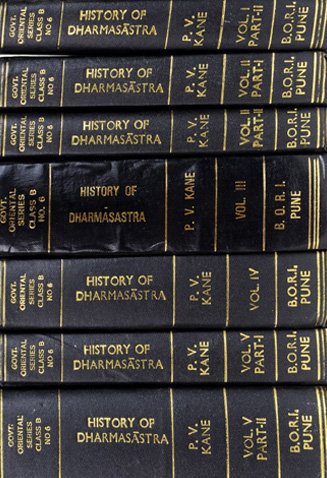
Dharmashastra (धर्मशास्त्र, dharmaśāstra) contains the instructions (shastra) regarding religious conduct of livelihood (dharma), ceremonies, jurisprudence (study of law) and more. It is categorized as smriti, an important and authoritative selection of books dealing with the Hindu lifestyle.
Kavya (poetry)
Source: archive.org: Naisadhacarita of SriharsaTāra (तार) refers to “bright”, “radiant”, and is mentioned in the Naiṣadha-carita 7.29. The word means “radiant” in the [passages of] Maṅkhaka 10.11; Haravijaya 23.62; 7.64; 5.149; 5.111; 4.2.

Kavya (काव्य, kavya) refers to Sanskrit poetry, a popular ancient Indian tradition of literature. There have been many Sanskrit poets over the ages, hailing from ancient India and beyond. This topic includes mahakavya, or ‘epic poetry’ and natya, or ‘dramatic poetry’.
Chandas (prosody, study of Sanskrit metres)
Source: Journal of the University of Bombay Volume V: Apabhramsa metres (2)Tārā (तारा) is the name of a catuṣpadi metre (as popularly employed by the Apabhraṃśa bards), as discussed in books such as the Chandonuśāsana, Kavidarpaṇa, Vṛttajātisamuccaya and Svayambhūchandas.—Tārā has 14 mātrās in each of its four lines, divided into the groups of 4, 4, [ISI] and [S] mātrās.
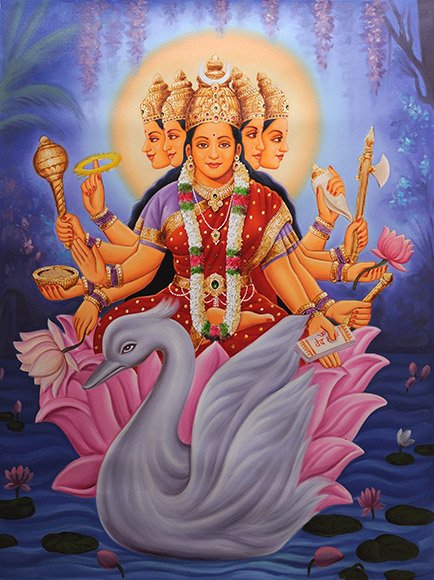
Chandas (छन्दस्) refers to Sanskrit prosody and represents one of the six Vedangas (auxiliary disciplines belonging to the study of the Vedas). The science of prosody (chandas-shastra) focusses on the study of the poetic meters such as the commonly known twenty-six metres mentioned by Pingalas.
Ayurveda (science of life)
Veterinary Medicine (The study and treatment of Animals)
Source: Shodhganga: Portrayal of Animal Kingdom (Tiryaks) in Epics An Analytical studyTāra (तार) is a synonym (another name) for the Horse (Aśva), according to scientific texts such as the Mṛgapakṣiśāstra (Mriga-pakshi-shastra) or “the ancient Indian science of animals and birds” by Hamsadeva, containing the varieties and descriptions of the animals and birds seen in the Sanskrit Epics such as the Ramayana and Mahabharata.
Unclassified Ayurveda definitions
Source: gurumukhi.ru: Ayurveda glossary of termsTāra (तार):—Element Silver-Argentinum with chemical symbol Ag at At. no. 47

Āyurveda (आयुर्वेद, ayurveda) is a branch of Indian science dealing with medicine, herbalism, taxology, anatomy, surgery, alchemy and related topics. Traditional practice of Āyurveda in ancient India dates back to at least the first millenium BC. Literature is commonly written in Sanskrit using various poetic metres.
Jyotisha (astronomy and astrology)
Source: Wisdom Library: Brihat Samhita by VarahamihiraTāra (तार) (Cf. Tāraka) refers to the “disc” of Ketus (i.e., luminous bodies such as comets and meteors), according to the Bṛhatsaṃhitā (chapter 11), an encyclopedic Sanskrit work written by Varāhamihira mainly focusing on the science of ancient Indian astronomy astronomy (Jyotiṣa).— Accordingly, “Jala Ketu is a comet which appears in the west with a raised tail; it is glossy, when it appears there will be prosperity in the land for 9 months, and the world will be freed from all miseries. Bhava Ketu is a comet visible only for a single night and in the east, possessing a small disc [i.e., sūkṣma-tāraka]; it is glossy; the tail is bent like that of a lion. There will be unprecedented happiness in the land for as many months as the number of hours for which it continues to be visible; if it should be fearful to look at, fatal diseases will afflict mankind”.

Jyotisha (ज्योतिष, jyotiṣa or jyotish) refers to ‘astronomy’ or “Vedic astrology” and represents the fifth of the six Vedangas (additional sciences to be studied along with the Vedas). Jyotisha concerns itself with the study and prediction of the movements of celestial bodies, in order to calculate the auspicious time for rituals and ceremonies.
Gitashastra (science of music)
Source: Shodhganga: Elements of Art and Architecture in the Trtiyakhanda of the Visnudharmottarapurana (gita)1) Tāra (तार) refers to a “high pitch” (in music), according to the Viṣṇudharmottarapurāṇa, an ancient Sanskrit text which (being encyclopedic in nature) deals with a variety of cultural topics such as arts, architecture, music, grammar and astronomy.—In Indian Music, the word saptaka is used to denote the scale or octave of Music. Actually the scale of seven notes is called as saptaka. According to the Viṣṇudharmottarapurāṇa, three kinds of scales or octaves viz., mandra i.e., low pitch, madhya i.e., medium pitch and tāra i.e., high pitch are there in Music and these three kinds of octaves occur from the three respective sthānas viz., chest, throat and head. The mandra-saptaka is basically the amalgamation of low notes which come out from the deep of the heart. The madhya i.e., medium notes come from the throat and the tāra i.e., high notes come from the head. To practise classical Music, the singers are generally seen to adopt the madhya-saptaka i.e., middle scale.
2) Tāra (तार) refers to one of the thirteen Jātis or “proper combination of two grāmas” (in Indian music), according to the Kallinātha’s commentary Kalānidhi on the Saṃgītaratnākara.—In the Nāṭyaśāstra, jātis are broadly divided into two types viz., śuddhā and vikṛtā. The Saṃgītaratnākara also agrees on it. But in the Viṣṇudharmottarapurāṇa, the reference about the types of jātis is not found. The Saṃgītaratnākara accepts thirteen kinds of characteristic features of jātis. For example: Tāra, which is also accepted by the Nāṭyaśāstra.
Gitashastra (गीतशास्त्र, gītaśāstra) refers to the ancient Indian science of Music (gita or samgita), which is traditionally divided in Vocal music, Instrumental music and Dance (under the jurisdiction of music). The different elements and technical terms are explained in a wide range of (often Sanskrit) literature.
Yoga (school of philosophy)
Source: ORA: Amanaska (king of all yogas): A Critical Edition and Annotated Translation by Jason BirchTārā (तारा) refers to “pupils (of the eye)”, according to sources such as the Candrāvalokana and the Anubhavanivedanastotra.—Accordingly, while describing the highest reality through the practice of Śāmbhavī Mudrā: “When the Yogin’s mind and breath have dissolved into his inward focus, while he is looking outwards and below and [yet] also not looking [at anything] with a gaze in which his pupils are unmoving (niścala-tārā), [then] this, indeed, is Śāmbhavī Mudrā. O guru, by your favour, it is that state of Śambhu which manifests as the [highest] reality free from what is void and not void. [...]”.

Yoga is originally considered a branch of Hindu philosophy (astika), but both ancient and modern Yoga combine the physical, mental and spiritual. Yoga teaches various physical techniques also known as āsanas (postures), used for various purposes (eg., meditation, contemplation, relaxation).
General definition (in Hinduism)
Source: Apam Napat: Indian MythologyTara is the wife of Brihaspati. She bore him seven sons and a daughter. She commited adultery with Chandra and gave birth to his son Budha.
Source: WikiPedia: HinduismIn Hinduism, the goddess Tārā (तारा) meaning “star”, is the second of the Dasa (ten) Mahavidyas or “Great Wisdom goddesses”, is a form of Durga or Parvati. Tantric manifestations of Durga or Mahadevi, Kali, or Parvati. As the star is seen as a beautiful but perpetually self-combusting thing, so Tara is perceived at core as the absolute, unquenchable hunger that propels all life.
In Buddhism
Tibetan Buddhism (Vajrayana or tantric Buddhism)
Source: Wisdom Library: Tibetan Buddhism1) Tārā (तारा) is the name of Vidyārājñī (i.e., “wisdom queen”) mentioned as attending the teachings in the 6th century Mañjuśrīmūlakalpa: one of the largest Kriyā Tantras devoted to Mañjuśrī (the Bodhisattva of wisdom) representing an encyclopedia of knowledge primarily concerned with ritualistic elements in Buddhism. The teachings in this text originate from Mañjuśrī and were taught to and by Buddha Śākyamuni in the presence of a large audience (including Tārā).
2) Tāra (तार) refers to one of the various Grahas and Mahāgrahas mentioned as attending the teachings in the 6th century Mañjuśrīmūlakalpa.
Source: archive.org: The Indian Buddhist Iconography1) Tārā refers to a group of deities according to different colours.—Tārā is the common name applied to a large number of feminine deities in the Buddhist pantheon. In the Sādhanamālā, Jāṅgulī, Parṇaśabarī. Mahācīnatārā, Ekajaṭā and many others are called Tārās, including Khadiravaṇī.
Strictly speaking, only those deities can be called Tārās to whom the mantra: “oṃ tārā tuttāre ture svāhā” is assigned. In the simplest form Tārās carry the night lotus in the left hand and exhibit the varadamudrā in the right. Some of them bear the miniature image of Amoghasiddhi on their crowns, but others may not have any effigy of the Dhyāni Buddha.
From the colour of the different Tārās it will be possible to refer them to their respective Kulas or families presided over by the five Dhyāni Buddhas.
- Green Tārā,
- White Tārā,
- Yellow Tārā,
- Blue Tārā,
- Red Tārā.
2) Tārā (तारा) or Tāriṇī is the Śakti, or female counterpart (spiritual consort) of Amoghasiddhi: one of the Dhyāni-Buddhas, according to Vajrayāna or Tantric Buddhism.—Her colour is green; and her symbol is utpala.—According to a Dhyāna found in the Pañcākāra section of the Advayavajrasaṃgraha, [Tārā] belongs to the Karma family to which evidently the Dhyāni Buddha Amoghasiddhi is also associated. The green colour of Tārā also suggest that she is the spiritual consort of Amoghasiddhi of green colour.
Tārā’s form and nature are given in the Advayavajrasaṃgraha:—“In the īśāna corner on the orb of the moon there is Tāriṇī originating from the germ syllable Tāṃ of golden green colour. Her recognition symbol is a green night lotus. She is the embodiment of the element of Air. She belongs to the Karma family and is full of jealousy”.
Tārā (तारा) is the presiding deity of the western lotus of the vārāhyabhyudaya-maṇḍala, according to the Vārāhyabhyudayatantra (largerly extracted from the 10th century Abhidhānottaratantra). She is the presiding lady (kuleśvarī) of the padma (Amitābha) family. The central deity of the vārāhyabhyudaya-maṇḍala is the twelve-armed Vajravarāhī, which is modeled upon the twelve-armed Cakrasaṃvara, thus inhibiting many similar iconographical features.
Tārā has three faces of three colors (red, yellow and green) and is to be visualised as naked and wearing only a agarland of heads, dancing upon the four māras. She has six arms and her attributes include the cihnam (family emblem), the vajra, the double vajra, a red lotus and a wheel.
The lotus upon which Tārā presides has 6 petals and corresponding goddesses residing in pīṭhas (sacred site):
- Śyāmā in Kaliṅga,
- Subhadrā in Lampāka,
- Hayakarṇā in Kāñcī,
- Khagānanā in Himālaya,
- Cakravegā in Pretapurī,
- Khaṇḍarohā in Gṛhadevatā.
2) Tārā (तारा) is an alternative name of Narteśvarī: a deity to be contemplated upon by a practicioner purifying his correspondences (viśuddhi), according to the 12th-century Abhisamayamañjarī. Narteśvarī is alternatively known by the name Tārā, one of the traditional consorts of the Buddha and a mother of the yogatantra system. The contemplation is prescribed as a preliminary ritual for a yogin wishing to establish, or reestablish the union with a deity.
Tārā is associated with the element wind and the color green. She is to be visualised as assuming a kāpālika form, naked with loose hair and holding tantric attributes in their four arms.
Source: academia.edu: The Structure and Meanings of the Heruka MaṇḍalaTārā (तारा) or Tārī is the name of a Ḍākinī who, together with the Vīra (hero) named Tāra forms one of the 36 pairs situated in the Hṛdayacakra, according to the 10th century Ḍākārṇava chapter 15. Accordingly, the hṛdayacakra refers to one of the four divisions of the sahaja-puṭa (‘innate layer’), situated within the padma (lotus) in the middle of the Herukamaṇḍala. The 36 pairs of Ḍākinīs [viz., Tārā] and Vīras are reddish yellow in color; they each have one face and four arms; they hold a skull bowl, a skull staff, a small drum, and a knife.

Tibetan Buddhism includes schools such as Nyingma, Kadampa, Kagyu and Gelug. Their primary canon of literature is divided in two broad categories: The Kangyur, which consists of Buddha’s words, and the Tengyur, which includes commentaries from various sources. Esotericism and tantra techniques (vajrayāna) are collected indepently.
General definition (in Buddhism)
Source: Wisdom Library: Dharma-samgrahaTārā (तारा) refers to the “shining goddess” and represents one of the “four Goddesses” (caturdevī) as defined in the Dharma-saṃgraha (section 4). The Dharma-samgraha (Dharmasangraha) is an extensive glossary of Buddhist technical terms in Sanskrit (e.g., caturdevī and Tārā). The work is attributed to Nagarguna who lived around the 2nd century A.D.
Source: Shambala Publications: GeneralTārā Skt. (Tib., Dolma), lit., “savior”; an emanation of the bodhisattva Avalokiteshvara, said to arise from his tears in order to help him in his work. She embodies the feminine aspect of compassion and is a very popular deity in Tibetan Buddhism. The cult of Tārā was propagated in the 11th century, primarily by Atīsha. Since that time, veneration of Tārā as a yidam has been quite widespread. There are twenty-one forms of Tārā, which are differentiated iconographically by color, posture of the body, and differing attributes, and can in addition appear in either a peaceful or a wrathful manifestation. The most frequently encountered forms are Green Tara and White Tara. The two consorts of the Tibetan king Songtsen Gampo (7th century) are regarded as having been embodiments of these two Tārās.
In Jainism
General definition (in Jainism)
Source: archive.org: Een Kritische Studie Van Svayambhūdeva’s PaümacariuTāra (तार) participated in the war between Rāma and Rāvaṇa, on the side of the latter, as mentioned in Svayambhūdeva’s Paumacariu (Padmacarita, Paumacariya or Rāmāyaṇapurāṇa) chapter 57ff. Svayambhū or Svayambhūdeva (8th or 9th century) was a Jain householder who probably lived in Karnataka. His work recounts the popular Rāma story as known from the older work Rāmāyaṇa (written by Vālmīki). Various chapters [mentioning Tāra] are dedicated to the humongous battle whose armies (known as akṣauhiṇīs) consisted of millions of soldiers, horses and elephants, etc.
Source: archive.org: The Jaina IconographyTārā (तारा) (or Dhāraṇī) is the name of the Yakṣiṇī accompanying Aranātha: the eighteenth of twenty-four Tīrthaṃkaras or Jinas, commonly depicted in Jaina iconography.—The eighteenth Jina Aranātha carries with him the mystic symbol of either the Nandyāvarta (a kind of Svastika) or a fish. His ministerial staff consists of the Yakṣa named Yakṣendra and Yakṣiṇī named Dhāraṇī Devī. The sacred tree peculiar to him is Cūta or mango tree. Govinda Rāja had the honour of holding his fly-whisk.
The Śvetāmbara texts described Dhāraṇī Yakṣiṇī as seated on a lotus and possessing four hands with a citrus, two lotuses, and a rosary. Tārā, the Yakṣiṇī of the Digambara is to appear, according to them, as riding on a swan and holding a snake, Vajra, deer and Varada-mudrā. In this case, like more cases, the Yakṣiṇī Dhāraṇī bears the Yakṣa symbol of a citrus together with other symbols, which explain her mixed origin. The name Tārā renders her connection with the Brahmanie Tārā almost obvious. The snake symbol in her hand is primarily common to the deity of either sects.
Source: archive.org: Trisastisalakapurusacaritra1) Tārā (तारा) is the mother of Śubhūma: one of the Cakrins (Cakravartins), according to chapter 1.6 [ādīśvara-caritra] of Hemacandra’s 11th century Triṣaṣṭiśalākāpuruṣacaritra: an ancient Sanskrit epic poem narrating the history and legends of sixty-three illustrious persons in Jainism.
Accordingly: “[...] In Bharata there will be twenty-three other Arhats and eleven other Cakrins. [...] The Cakrins will belong to the gotra of Kaśyapa, gold-color, and eight of them will go to mokṣa. [...] Son of Tārā and Kṛtavīrya, Subhūma will live for sixty thousand years in Hastināpura, twenty-eight bows tall, and in the interval between Ara and Malli will go to the seventh hell”.
2) Tārā (तारा) is the chief-queen of Kṛtavīrya (son of Anantavīrya, king of Hastināpura), according to chapter 6.4 [subhūma-cakravartin-caritra].—Accordingly:—“[...] Kṛtavīrya, powerful, though he was young, was established in his kingdom by the ministers. His chief-queen was starry-eyed Tārā and they enjoyed pleasures unhindered, like gods. [...]”.
3) Tārā (तारा) is the daughter of the Vidyādhara-lord from Jyotiḥpura, according to the Jain Ramayana and chapter 7.2 [Rāvaṇa’s expedition of conquest].—Accordingly, “Now, in the city Jyotiḥpura on Mt. Vaitāḍhya there was a Vidyādhara-lord, Jvalanaśikha. He had a beautiful queen, Śrīmatī, and by her a bright-eyed daughter, Tārā. One day Sāhasagati, the son of Cakrāṅka, a Vidyādhara-king, saw her and was immediately wounded by love. Sāhasagati asked Jvalana for her through agents and also Sugrīva, king of the Vānaras (asked for her). [...]”.
Source: The University of Sydney: A study of the Twelve ReflectionsTāra (तार) or Tāraka refers to the “stars”, according to the 11th century Jñānārṇava, a treatise on Jain Yoga in roughly 2200 Sanskrit verses composed by Śubhacandra.—Accordingly, “Fool, you must understand, in reality, substance is not acknowledged in a mass of foam, the trunk of a plantain tree or in the body of human beings. The planets, moon, sun, stars (grahacandrārkatārakāḥ; var.: tāra—grahatārārkacandramāḥ) and seasons go and come [but] certainly for embodied souls bodies do not [go and come] even in a dream”.

Jainism is an Indian religion of Dharma whose doctrine revolves around harmlessness (ahimsa) towards every living being. The two major branches (Digambara and Svetambara) of Jainism stimulate self-control (or, shramana, ‘self-reliance’) and spiritual development through a path of peace for the soul to progess to the ultimate goal.
India history and geography
Source: Cologne Digital Sanskrit Dictionaries: Indian Epigraphical GlossaryTara.—(EI 9), same as nilaya; the family aggregate of dwel- lings with some of them meant for servants and artisans; also a strect or a hamlet. (HRS), same as tara-deya, ferry dues, as indicated by the Arthaśāstra. See tārya. Cf. taram (EI 7), revenue. Note: tara is defined in the “Indian epigraphical glossary” as it can be found on ancient inscriptions commonly written in Sanskrit, Prakrit or Dravidian languages.

The history of India traces the identification of countries, villages, towns and other regions of India, as well as mythology, zoology, royal dynasties, rulers, tribes, local festivities and traditions and regional languages. Ancient India enjoyed religious freedom and encourages the path of Dharma, a concept common to Buddhism, Hinduism, and Jainism.
Biology (plants and animals)
Source: Wisdom Library: Local Names of Plants and DrugsTara in the Bengali language is the name of a plant identified with Alpinia nigra (Gaertn.) Burtt from the Zingiberaceae (Ginger) family having the following synonyms: Alpinia allughas, Amomum nigrum. For the possible medicinal usage of tara, you can check this page for potential sources and references, although be aware that any some or none of the side-effects may not be mentioned here, wether they be harmful or beneficial to health.
Source: Google Books: CRC World Dictionary (Regional names)1) Tara in Bangladesh is the name of a plant defined with Alpinia nigra in various botanical sources. This page contains potential references in Ayurveda, modern medicine, and other folk traditions or local practices It has the synonym Amomum nigrum (Gaertn.) Raeusch. (among others).
2) Tara in India is also identified with Acacia catechu It has the synonym Senegalia catechu (L.f.) P.J.H. Hurter & Mabb. (etc.).
3) Tara is also identified with Alpinia malaccensis It has the synonym Catimbium malaccense (Burm.f.) Holttum (etc.).
4) Tara is also identified with Alpinia roxburghii It has the synonym Languas blepharocalyx (K. Schumann) Handel-Mazzetti (etc.).
5) Tara in Ivory Coast is also identified with Excoecaria grahamii It has the synonym Sapium grahamii Prain (etc.).
Example references for further research on medicinal uses or toxicity (see latin names for full list):
· London Journal of Botany (1842)
· Flora Indica (1768)
· Symb. Sin.
· Journal of Economic and Taxonomic Botany (1996)
· Plant-Book
· Journal of Economic and Taxonomic Botany (1981)
If you are looking for specific details regarding Tara, for example health benefits, side effects, diet and recipes, extract dosage, chemical composition, pregnancy safety, have a look at these references.

This sections includes definitions from the five kingdoms of living things: Animals, Plants, Fungi, Protists and Monera. It will include both the official binomial nomenclature (scientific names usually in Latin) as well as regional spellings and variants.
Languages of India and abroad
Pali-English dictionary
Source: BuddhaSasana: Concise Pali-English Dictionarytara : (adj.) (in cpds.), crossing; passing over. || tārā (f.), star.
Source: Sutta: The Pali Text Society's Pali-English DictionaryTārā, (f.) (Sk. tārā=Gr. a)stήr, a)ζton (=Lat. astrum, in E. disaster), Lat. stella, Goth. staírnō, Ohg. sterro (: E. star), perhaps loan word from Semitic sources) a star, a planet Sn. 687 (tārāsabha the lord, lit. “the bull” of the stars, i.e. the Moon).
— or —
Tara, (see tarati) (n.) crossing, “transit, ” passing over Sn. 1119 (maccu°).—(adj.) to be crossed, passable, in duttara hard to cross S. IV, 157; Sn. 174, 273 (oghaṃ t. duttaraṃ); Th. 2, 10; It. 57. Also as su-duttara S. I, 35; V, 24.

Pali is the language of the Tipiṭaka, which is the sacred canon of Theravāda Buddhism and contains much of the Buddha’s speech. Closeley related to Sanskrit, both languages are used interchangeably between religions.
Marathi-English dictionary
Source: DDSA: The Molesworth Marathi and English Dictionaryṭara (टर).—f Ridiculing, jeering, deriding: also ridiculed state. v uḍava, kara, uḍa, hō.
--- OR ---
ṭara (टर).—f (Imit.) The whirr! of a spinning top or whirligig.
--- OR ---
ṭāra (टार).—a Wild, wicked, unruly, full of pranks and mischief--a child.
--- OR ---
ṭāra (टार).—m A term for a horse in mentioning the four things of which the price or value is ever varying, or which carry off money beyond all computation; viz. ṭāra, nāra, gāra, sāra, horses, women, jewelry, draughts (i. e. dice). ṭāra n is A puny or sorry horse, and answers to rip, jade, hack. Hence applied angrily to a little and mischievous child.
--- OR ---
tara (तर).—f (S) A ferry-boat: also a raft or float. 2 A ferry. tarīpāra karaṇēṃ To ferry over; to deport over the seas; to transport.
--- OR ---
tara (तर).—ind An adjunct to Sanskrit adjectives, denoting the comparative degree; as duṣṭa, duṣṭatara, Bad, worse.
--- OR ---
tara (तर).—ad Then, in that case; correlative with jara If &c. 2 tara occurs variously as an expletive, and often with great significance and force. Ex. hō ātāṃ mī jātōṃ tara I will not budge a peg; tumhī tara lākha rūpayē māgatāṃ āṇi mī tara kēvaḷa garība paḍalōṃ. madhyēṃ tara disatēṃ or āhē Expresses contingency or conditionality. See parantu.
--- OR ---
tāra (तार).—f ( P) A wire; a piece of catgut; a string of silk &c. 2 A filament or thread of any viscous or inspissated substance. 3 Intoxication: also dullness from watching; dimness of vision from bile &c. v caḍha, yē, lāga. 4 fig. Habitual mind or bearing: also fixed attention; earnest engagedness. v lāga. 5 (Esp. in pl tārā) A low and allusive term for a hair of the pubes. Hence tārā upaṭaṇēṃ, tārā upaṭaṇārā &c. in the vulgar tongue. 6 fig. Thread, train, tenor, connection (as of a discourse). v lāva, lāga, dhara, sōḍa, suṭa. 7 Long-continuing train, proceeding, or subsisting (of a work, as of ploughing, writing, singing, or of any state, as of raining, shining, blowing); a consecution or course gen. v lāva, lāga. tāra ōḷakhaṇēṃ or jāṇaṇēṃ g. of o. To understand the mind, leaning, inclining of. tāra rākhaṇēṃ-sambhāḷaṇēṃ &c. To preserve the good will of. tārēsa ubhā rāhaṇēṃ or tārēnēṃ vāgaṇēṃ or cālaṇēṃ g. of o. To walk in the ways of: also tārēsa ubhā karaṇēṃ, tārēsa utaraṇēṃ g. of o. To meet the pleasure or mind of. tārēsa lāgaṇēṃ or asaṇēṃ To be engrossed by the desire or contemplation of. tārā tōḍaṇēṃ (To snap the chords.) To roar or bellow (overbearingly). gaḷā tāra āhē g. of s. (His &c.) throat is a musical chord. Said of a vocalist.
--- OR ---
tārā (तारा).—m (S) A star. 2 The pupil of the eye. 3 A meteor; a falling star. v tuṭa. 4 A firework,--a kind of rocket. 5 In astrology. The quotient resulting from dividing by nine the number obtained by counting from janmanakṣatra to any candranakṣatra. 6 A term for a smart, expert, clever fellow; an adept, a dabster: also for a beautiful or handsome person. tārē tuṭaṇēṃ To shoot--stars. 2 fig. To shine (in singing); to warble divinely. Said ironically of wretched screaming. Ex. kāya gāṇyācē tārē tuṭa- tāta hō! Said also of foolish talking. Used also, in praise, both of singing and of talking.
--- OR ---
tārā (तारा).—m (tāraṇēṃ or taraṇēṃ) Fordableness or a ford (esp. of creeks and inlets at low water). 2 Floating (upon water or in the air); as jahājācā- mahāgirīcā-vāvaḍīcā-ghārīcā-tārā.
Source: DDSA: The Aryabhusan school dictionary, Marathi-Englishṭara (टर).—f Ridiculing, jeering, deriding also ridiculed state.
--- OR ---
ṭara (टर) [-kan-kara-dinī-diśī, -कन्-कर-दिनी-दिशी].—ad Imit. of the sound in rending.
--- OR ---
tara (तर).—ad Then. f A ferry-boat; a raft. A ferry. tarīpāra karaṇēṃ Ferry over; transport.
--- OR ---
tāra (तार).—f A wire. A filament of any viscous substance. Intoxication. Habitual mind. Long-continuing train. tāra sambhā- ḷaṇēṃ To preserve the good-will of. tārēnēṃ vāgaṇēṃ To walk in the ways of. tārēsa lāgaṇēṃ To be engrossed. tāra tōḍaṇēṃ To roar or bellow.
--- OR ---
tārā (तारा).—m A star. The pupil of the eye. A meteor. A firework. A clever or hand- some fellow. tārē tuṭaṇēṃ To shoot-stars To warble divinely, said ironically of bad singing, also of foolish talking. Used also in praise of good singing or talking.
Marathi is an Indo-European language having over 70 million native speakers people in (predominantly) Maharashtra India. Marathi, like many other Indo-Aryan languages, evolved from early forms of Prakrit, which itself is a subset of Sanskrit, one of the most ancient languages of the world.
Sanskrit dictionary
Source: DDSA: The practical Sanskrit-English dictionaryṬāra (टार).—
1) A horse.
2) A catamite.
Derivable forms: ṭāraḥ (टारः).
--- OR ---
Tara (तर).—A Taddihita affix of the comparative degree, added to adjectives, nouns, and also to verbs and indeclinables in which latter case it is changed to तराम् (tarām). It is added, like तम (tama), to pronouns in the sense of 'one of two' e. g. कतर, ततर, यतर (katara, tatara, yatara) &c.
--- OR ---
Tara (तर).—&c. See under तॄ (tṝ).
See also (synonyms): taraṇa, taraṇi, taraṇḍa, tari, tarīṣa.
--- OR ---
Tāra (तार).—a. [tṝ-ṇic bhāve ac]
1) High (as a note.)
2) Loud, shrill (as a sound); नादस्तावद्विकलकुररीकूजितस्निग्ध- तारः (nādastāvadvikalakurarīkūjitasnigdha- tāraḥ) Mālatīmādhava (Bombay) 5.2.
3) Shining, radiant, clear; हारांस्तारां- स्तरलगुटिकान् (hārāṃstārāṃ- staralaguṭikān) (regarded as an interpolation in Me. by Malli.); उरसि निहितस्तारो हारः (urasi nihitastāro hāraḥ) Amaruśataka 31; R.5.52.
4) Good, excellent, well-flavoured.
5) Clear, clean; 'तारो मुक्तादिसंशुद्धौ (tāro muktādisaṃśuddhau)' इति विश्वः (iti viśvaḥ); Śiśupālavadha 18.44.
-raḥ 1 The bank of a river.
2) The clearness of a pearl.
3) A beautiful or big pearl; हारममलतरतारमुरसि दधतम् (hāramamalataratāramurasi dadhatam) Gītagovinda 11.
4) An epithet of (1) Visnu, (2) Śiva.
5) The mystical syllable ओम् (om) (praṇava).
6) Protection.
7) A high tone or note; दध्मौ शङ्खं च तारेण सिंहनादं ननाद च (dadhmau śaṅkhaṃ ca tāreṇa siṃhanādaṃ nanāda ca) Mahābhārata (Bombay) 7.156.9.
8) Crossing, passing over.
9) A thread, wire (tantu); यदा गतोद्वाहमकूजनाक्षं सुवर्णतारं रथमाततायी (yadā gatodvāhamakūjanākṣaṃ suvarṇatāraṃ rathamātatāyī) Mahābhārata (Bombay) 5.48.28.
-raḥ, -ram 1 A star or planet; (said to be f. also).
2) The pupil of the eye; (said to be -m. also).
3) A pearl (said to be f. also).
-ram 1 Silver; तारहेममहारत्नविमानशतसङ्- कुलम् (tārahemamahāratnavimānaśatasaṅ- kulam) Bhāgavata 4.6.27.
2) A seed-vessel (esp. of the lotus); शुक्लैः सतारैर्मुकुलीकृतैः स्थुलैः कुमुद्वतीनां कुमुदाकरैरिव (śuklaiḥ satārairmukulīkṛtaiḥ sthulaiḥ kumudvatīnāṃ kumudākarairiva) Śiśupālavadha 12.4.
--- OR ---
Tārā (तारा).—
1) A star or planet in general; हंसश्रेणीषु तारासु (haṃsaśreṇīṣu tārāsu) R.4.19; Bhartṛhari 1 15.
2) A fixed star; Y.3.172; R. 6.22.
3) The pupil of the eye, the eye-ball; कान्तामन्तः- प्रमोदादभिसरति मदभ्रान्ततारश्चकोरः (kāntāmantaḥ- pramodādabhisarati madabhrāntatāraścakoraḥ) Mālatīmādhava (Bombay) 9.3; विस्मयस्मेरतारैः (vismayasmeratāraiḥ) 1.28; Kumārasambhava 3.47.
4) A pearl.
5) (in Sāṅkhya Phil.) One of the 8 Siddhis.
6) (in music) Name of a Rāga of six notes.
7) A kind of perfume.
8) (a) Name of the wife of Vāli, king of the monkeys, and mother of Aṅgada. She in vain tried to dissuade her husband Vāli from fighting with Rāma and Sugrīva, and married Sugrīva after Vāli had been killed by Rāma. (b) Name of the wife of Bṛhaspati, the preceptor of the gods. She was on one occasion carried off by Soma (the moon) who refused to deliver her up to her husband when demanded. A fierce contest then ensued, and Brahmā had at last to compel Soma to restore her to her husband. Tārā gave birth to a son named Budha who became the ancestor of the Lunar race of kings (see Bhāgavata 9.14). (c) Name of the wife of Hariśchandra and mother of Rohidāsa (also called Tārāmatī). (d) Name of a Buddha goddess. (e) Name of a Śakti; Jaina.
--- OR ---
Tara (तर).—a. [tṝ-bhāve-ap]
1) Crossing.
2) Surpassing, excelling.
3) Conquering, overpowering; cf. दुस्तर (dustara).
-raḥ 1 Passing over, crossing, passage; उत्तेऊरतरान् नदान् (utteūratarān nadān) Bhaṭṭikāvya 7.55.
2) Freight; दीर्घाध्वनि यथादेशं यथाकालं तरो भवेत् (dīrghādhvani yathādeśaṃ yathākālaṃ taro bhavet) Manusmṛti 8.46.
3) A road.
4) A ferry-boat.
5) Fire.
Source: Cologne Digital Sanskrit Dictionaries: Edgerton Buddhist Hybrid Sanskrit DictionaryTārā (तारा).—name of a Buddhistic goddess: Mahāvyutpatti 4280; Dhar-mas 4; Sādhanamālā 18.16 etc.; (Ārya-)Mañjuśrīmūlakalpa 10.16, at the head of a list of vidyārājñī; 40.10; 65.9, called ‘compassion of Avalo- kiteśvara’, Āryāvalokiteśvara-karuṇā; 69.16; 312.6; 576.11 etc.; 647.12 ff.
--- OR ---
Tārā (तारा) or Tāriṇī.—: Sādhanamālā 208.2 (prose), etc.
Source: Cologne Digital Sanskrit Dictionaries: Shabda-Sagara Sanskrit-English DictionaryṬāra (टार).—m.
(-raḥ) 1. horse. 2. A catamite. E. ṭāṃ pṛthvīmṛcchati ṛ-aṇ .
--- OR ---
Tara (तर).—mfn.
(-raḥ-rā-rī-raṃ) Who or what passes over or beyond. m.
(-raḥ) 1. Passing over, crossing. 2. A float, a raft. 3. A road. 4. A tree. f. (-rī) 1. A boat. 2. A club. 3. A clothes basket, a Pitara. 4. Smoke. 5. A small wooden baling vessel. 6. The end of a garment. E. tṝ to cross, affix bhāve ap, fem. affix ṅīṣ; also with in affix tari, q. v. karttari ac . kṛśānau pu0 tarati anena karaṇe ap . ātare paṇādau .
--- OR ---
Tāra (तार).—mfn. adj.
(-raḥ-rā-raṃ) 1. High, as a note in music. 2. Radiant, shining, radiating. 3. Clean, clear. 4. Good, excellent, well flavoured, &c. m.
(-raḥ) 1. A high note or tone in music. 2. Elegance of a pearl. 3. A clear or beautiful pearl. 4. Crossing, passing over, &c. 5. A wire, a cord. 6. The mystic monosyllable Om. 7. A mystical monosyllable in the Tantras. 7. The name of a monkey chief, the son Bali. N.
(-raṃ) 1. Silver. 2. A pearl. mfn. subst.
(-raḥ-rā-raṃ) 1. The pupil of the eye. 2. A star in general, a planet, as asterism, &c. f.
(-rā) A female deity peculiar to the Baud'dha sect. 2. The wife of Vrihaspati. 3. The wife of the monkey king Bali. 4. A name of the goddes Durga. E. tṝ to pass or proceed; also in the causal, to cause to pass, and ṇic, ac or ghañ aff. saṃsārārṇavāt tārayati svajāpakān .
Source: Cologne Digital Sanskrit Dictionaries: Benfey Sanskrit-English DictionaryTara (तर).—i. e. tṛ10 + a, I. adj. Conquering, Mahābhārata 12, 10380. Ii. m. 1. Passage, crossing, [Mānavadharmaśāstra] 8, 407. 2. Freight, [Mānavadharmaśāstra] 8, 406. 3. A certain spell for banishing demons, [Rāmāyaṇa] 1, 30, 4.
--- OR ---
Tāra (तार).—A. i. e. tṛ10 + a, I. adj. 1. Saving, Mahābhārata 13, 6986. 2. Piercing, [Mṛcchakaṭikā, (ed. Stenzler.)] 44, 10; ºra + m, adv. Sounding loud, 92, 13. Ii. m. and n. A shrill loud sound, Mahābhārata 7, 6737. Iii. m. 1. A pearl, [Gītagovinda. ed. Lassen.] 11, 25. 2. A proper name, [Rāmāyaṇa] 1, 3, 24. B. (for original stāra, cf. 3. stṛ), I. (m.), f. rā (and n.), 1. A star, [Rāmāyaṇa] 1, 35, 16. 2. The pupil of the eye, [Ṛtusaṃhāra] 6, 31. Ii. f. rā, 1. A certain meteor, perhaps a shootingstar, [Varāhamihira's Bṛhajjātaka.] S. 32, 1. C. f. rā. 1. The knowledge which arises from reasoning in regard to the principles, the conditions of intellect, the elemental creation, Tattvas. 41 Ball. 2. The name of deities, Mahābhārata 5, 3972; of a monkey, [Rāmāyaṇa] 1, 1, 67. D. n. Silver, [Bhāgavata-Purāṇa, (ed. Burnouf.)] 4, 6, 27.
Source: Cologne Digital Sanskrit Dictionaries: Cappeller Sanskrit-English DictionaryTara (तर).—[adjective] crossing, surpassing, overcoming (—°); [masculine] passage, ferry, freight.
--- OR ---
Tāra (तार).—[adjective] all-pervading, [especially] of a sound, i.e. loud, high, shrill; or of light, i.e. shining, radiant.
— [masculine] passing over, crossing (only —°); saver, deliverer ([Epithet] of [several] gods), a clear or beautiful pearl, a man’s name. [feminine] ā a star or meteor, the pupil of the eye; [Name] of [several] goddesses & women. [neuter] descent to a river, bank; a loud or shrill sound (also [masculine]); tāram as [adverb] aloud; [comparative] tārataram, [superlative] tāratamam.
Source: Cologne Digital Sanskrit Dictionaries: Monier-Williams Sanskrit-English Dictionary1) Ṭāra (टार):—m. a horse, [cf. Lexicographers, esp. such as amarasiṃha, halāyudha, hemacandra, etc.]
2) a catamite, [cf. Lexicographers, esp. such as amarasiṃha, halāyudha, hemacandra, etc.]
3) Tara (तर):—1. tara an affix forming the [Comparative degree] degree of adjectives and rarely (cf. vṛtra-tara) of substantives, [Suśruta i, 20, 11]
4) (ām), added (in older language) to adverbs (See ati-tarām etc.) and (in later language) to verbs ([Pañcatantra i, 14, 7; Ratnāvalī iii, 9; Kathāsaritsāgara]), intensifying their meaning
5) ind. with na, not at all, [Bhāgavata-purāṇa x, 46, 43.]
6) 2. tara mfn. (√tṝ; [gana] pacādi) carrying across or beyond, saving (?, said of Śiva), [Mahābhārata xii, 10380]
7) ifc. passing over or beyond, [Horace H. Wilson]
8) ‘surpassing, conquering’ See śoka-tara cf. rathaṃtara
9) excelling, w.
10) m. crossing, passage, [Ṛg-veda ii, 13, 12; viii, 96, 1; Manu-smṛti viii, 404 and 407; Yājñavalkya] (ifc.), [Mahābhārata xii]
11) m. (a-tara mfn. ‘impassable’), [Bhaṭṭi-kāvya vii, 55] (cf. dus-)
12) m. ‘excelling, conquering’ See duṣ-ṭara, su-tara, dus-
13) = -paṇya, [Manu-smṛti viii, 406]
14) a raft, [Horace H. Wilson]
15) a road, [cf. Lexicographers, esp. such as amarasiṃha, halāyudha, hemacandra, etc.]
16) Name of a magical spell (against evil spirits supposed to possess certain weapons), [Rāmāyaṇa i, 30, 4]
17) fire, [Horace H. Wilson]
18) Name of a man, [Rājataraṅgiṇī vii, 809]
19) Tāra (तार):—mfn. (√tṝ) carrying across, a saviour, protector (Rudra), [Vājasaneyi-saṃhitā xvi, 40; Śira-upaniṣad]
20) (Viṣṇu), [Mahābhārata xiii, 6986]
21) high (a note), loud, shrill (mn.) a high tone, loud or shrill note, [Tāṇḍya-brāhmaṇa vii, 1, 7] ([Comparative degree] -tara and [superlative degree] -tama), [Taittirīya-prātiśākhya]
22) Śikṣā, [Mahābhārata vii; Mṛcchakaṭikā] etc.
23) ([from] stṛ?) shining, radiant, [Meghadūta; Amaru-śataka; Kathāsaritsāgara lxxiii; Sāhitya-darpaṇa]
24) clean, clear, [cf. Lexicographers, esp. such as amarasiṃha, halāyudha, hemacandra, etc.]
25) good, excellent, well flavoured, [cf. Lexicographers, esp. such as amarasiṃha, halāyudha, hemacandra, etc. [Scholiast or Commentator]]
26) m. ‘crossing’ See dus-, su-
27) ‘saving’, a mystical monosyllable (as om), [Rāmatāpanīya-upaniṣad; Yogaśikhā-upaniṣad; Sarvadarśana-saṃgraha; Tantr.]
28) Andropogon bicolor, [cf. Lexicographers, esp. such as amarasiṃha, halāyudha, hemacandra, etc.]
29) Name of Maṇi-rāma (author of a [commentator or commentary] on [Bhāminī-vilāsa])
30) of a Daitya (slain by Viṣṇu), [Harivaṃśa]
31) of one of Rāma’s monkey generals (son of Bṛhas-pati, husband of Tārā), [Mahābhārata iii, 16372; Rāmāyaṇa i, iv, vi]
32) [plural] a class of gods in the 12th Manv-antara, [Viṣṇu-purāṇa iii, 2, 33]
33) m. [n. and f(ā). , [cf. Lexicographers, esp. such as amarasiṃha, halāyudha, hemacandra, etc.]] the clearness or transparency of a pearl, clear pearl, [Suśruta v, 3, 19; Gīta-govinda xi, 25]
34) (m. n., [cf. Lexicographers, esp. such as amarasiṃha, halāyudha, hemacandra, etc.]) = rābhra, [cf. Lexicographers, esp. such as amarasiṃha, halāyudha, hemacandra, etc.]
35) m. n. a star, [cf. Lexicographers, esp. such as amarasiṃha, halāyudha, hemacandra, etc.]
36) the pupil of the eye, [cf. Lexicographers, esp. such as amarasiṃha, halāyudha, hemacandra, etc.]
37) n. descent to a river, bank (cf. tīra, tīrtha), [Atharva-veda iv, 37, 3; Pāṇini 6-3, 109], [vArttika] 1
38) silver, [Bhāgavata-purāṇa iv, 6, 27; Bhāvaprakāśa v, 26, 43]
39) Tārā (तारा):—[from tāra] a f. ([gana] bhidādi) a fixed star, asterism (cf. stṛ), [Yājñavalkya iii, 172; Mahābhārata] etc. (ifc. f(ā). , [Mṛcchakaṭikā iii, 10])
40) [v.s. ...] the pupil of the eye (chiefly ifc.), [Varāha-mihira’s Bṛhat-saṃhitā lviii, 11 etc.]
41) [v.s. ...] a kind of meteor, [vli, 86 and 94]
42) [v.s. ...] (in Sāṃkhya [philosophy]) one of the 8 Siddhis, [Tattvasamāsa]
43) [v.s. ...] (in music) Name of a Rāga of six notes
44) [v.s. ...] a kind of perfume, [cf. Lexicographers, esp. such as amarasiṃha, halāyudha, hemacandra, etc.]
45) [v.s. ...] a form of Dākṣāyaṇī (worshipped on the mountain Kiṣkindha, [Matsya-purāṇa xiii, 46]; protectress of the Gṛtsa-madas, [Brahma-purāṇa ii, 18, 8;] cf. [Religious Thought and Life in India] p.187)
46) [v.s. ...] Name of a, [Buddhist literature] goddess, [Vāsavadattā], 433
47) [v.s. ...] of Bṛhaspati’s wife (carried off by Soma), [Mahābhārata v, 3972; Harivaṃśa 1340 ff.; Bhāgavata-purāṇa] etc.
48) [v.s. ...] of the wife of Buddha Amoghasiddha, [Buddhist literature]
49) [v.s. ...] of a Śakti, [Jaina literature]
50) [v.s. ...] of a Yoginī, [Hemādri’s Caturvarga-cintāmaṇi ii, 1, 710]
51) [v.s. ...] of a female monkey (daughter of Suṣeṇa, wife of Bālin and mother of Aṅgada), [Mahābhārata iii, 16110 ff.; Rāmāyaṇa i, iv, vi.]
52) [from tāra] b f. of ra q.v.
Source: Cologne Digital Sanskrit Dictionaries: Yates Sanskrit-English Dictionary1) Ṭāra (टार):—(raḥ) 1. m. A house; a catamite.
2) Tara (तर):—(raḥ) 1. m. A float; a crossing; a road. f. (rī) A boat; a tree; a club; a basket; smoke; a baling vessel; end of a garment. a. Crossing, passing.
3) Tāra (तार):—(raḥ) 1. m. A high note or tone; a fine pearl; a wire; a crossing over; the mystic Om. f. A female deity; a star; pupil of the eye. n. Silver. a. High; clear; good.
Source: DDSA: Paia-sadda-mahannavo; a comprehensive Prakrit Hindi dictionary (S)Tara (तर) in the Sanskrit language is related to the Prakrit words: Taraga, Tāra, Tārā.
[Sanskrit to German]
Sanskrit, also spelled संस्कृतम् (saṃskṛtam), is an ancient language of India commonly seen as the grandmother of the Indo-European language family (even English!). Closely allied with Prakrit and Pali, Sanskrit is more exhaustive in both grammar and terms and has the most extensive collection of literature in the world, greatly surpassing its sister-languages Greek and Latin.
Hindi dictionary
Source: DDSA: A practical Hindi-English dictionary1) Tara (तर) [Also spelled tar]:—(a) wet, soaked; damp, dank; fresh; a suffix used to denote comparative degree (as [uccatara, mahattara, behatara]); rich (as food etc.—[tara māla]); -[ba-tara] soaked, drenched; -[o-tājā] freshed, refresh, revived; —[karanā] to soak, to drench; to refresh.
2) Tāra (तार) [Also spelled taar]:—(nm) a wire; thread; fibre; chord; string; telegram; series, non-stop sequence; order; (a) high pitched; ~[kaśa] a wire-maker; ~[kaśī] a kind of needlework; soft lustrous thread used for needlework; —[svara] high-pitched note; -[kutāra honā] things to go astray/out of order, disorder to prevail; -[tāra karanā] to shred; to reduce to shreds; -[tāra honā] to be reduced to shreds; —[na ṭūṭanā] sequence not to be broken, order to be retained; —[bigaḍanā] things to get confused/disturbed, to go into disarray.
3) Tārā (तारा):—(nm) a star: pupil (of the eye); ~[kāra] stellate; ~[kṛti] stellate; ~[gaṇa] congregation of stars; ~[maṃḍala] constellation; [tāre ginanā] lit. to count the stars—to keep awake the whole night; not to have a blink throughout the night; [tāre] [toḍa lānā] to achieve the impossible, to perform a miracle; [tāre dikhāī de jānā] lit. to see stars fleeting before the eye—to come face-to-face with a hard realisation; to be over-powered by a hardship; to be stunned helpless; [tāroṃ kī chāṃha meṃ] in the small hours of the morning, prior to day-break.
4) Tara in Hindi refers in English to:—(pro) possessive form of [tu]—thy, thine, your(s); -[sa/teri-si] favourable to you, serving your interest..—tara (तेरा) is alternatively transliterated as Terā.
...
Prakrit-English dictionary
Source: DDSA: Paia-sadda-mahannavo; a comprehensive Prakrit Hindi dictionary1) Tara (तर) in the Prakrit language is related to the Sanskrit word: Tvar.
2) Tara (तर) also relates to the Sanskrit word: Śak.
3) Tara (तर) also relates to the Sanskrit word: Taras.
4) Tarā (तरा) also relates to the Sanskrit word: Tvarā.
5) Tāra (तार) also relates to the Sanskrit word: Tāra.
6) Tāra (तार) also relates to the Sanskrit word: Tāra.
7) Tārā (तारा) also relates to the Sanskrit word: Tārā.
Prakrit is an ancient language closely associated with both Pali and Sanskrit. Jain literature is often composed in this language or sub-dialects, such as the Agamas and their commentaries which are written in Ardhamagadhi and Maharashtri Prakrit. The earliest extant texts can be dated to as early as the 4th century BCE although core portions might be older.
Kannada-English dictionary
Source: Alar: Kannada-English corpusTara (ತರ):—[noun] an onomatopoeic word imitating or suggesting the sound or condition of shivering, trembling tremulously.
--- OR ---
Tara (ತರ):—
1) [noun] a line in which persons or things or arranged (in an order).
2) [noun] that which is proper, right.
3) [noun] a class or rank based on one’s merits.
4) [noun] the quality that pleases senses, esp. the sight organ; beauty.
--- OR ---
Tara (ತರ):—[noun] a horizontal layer or section of a material, esp. any of several lying one upon another, as one of many layers of soil, sedimentary rock, etc.; a stratum.
--- OR ---
Tara (ತರ):—[noun] rapidity in moving, going, travelling, proceeding or performing; swiftness; speed.
--- OR ---
Tara (ತರ):—
1) [noun] 'a way of doing, being, being done or happening; mode of action, occurrence, etc.: manner.'2) [noun] likeness; resemblance.
--- OR ---
Taṟa (ತಱ):—
1) [noun] 'a way of doing, being, being done or happening; mode of action, occurrence, etc.: manner.'2) [noun] the quality that attracts the mind; beauty; attractiveness.
3) [noun] a matter or subject.
4) [noun] something that is helpful or useful to a desired end; a means.
--- OR ---
Tāra (ತಾರ):—[noun] a former monetary coin made of copper.
--- OR ---
Tāra (ತಾರ):—[noun] that which is dry, withered, faded.
--- OR ---
Tāra (ತಾರ):—
1) [adjective] (said of voice) high in pitch; shrill.
2) [adjective] (mus.) belonging to the octave above the normal one.
3) [adjective] most excellent; best.
--- OR ---
Tāra (ತಾರ):—
1) [noun] the act of crossing as from one side of a river to the other or from one stage to the another; a crossing.
2) [noun] the act of staying or moving on, without going down under, the surface of a liquid; a floating.
3) [noun] the act or motion of swimming.
4) [noun] a going or coming down from a higher place or position to the lower one.
5) [noun] a shrill sound.
6) [noun] silver.
7) [noun] the contractile circular opening, apparently black, in the centre of the iris of the eye; the pupil.
8) [noun] any of the luminous celestial objects seen as points of light in the sky; a star.
9) [noun] a genuine pearl.
10) [noun] a necklace with a pearl or pearls.
11) [noun] air or wind.
12) [noun] a natural, relatively large, stream of water, usu. emptying into an ocean, lake or another river; a river.
13) [noun] the apparent blue canopy over our heads; the sky.
14) [noun] the mystic syllable 'ಓಮ್ [om]'.
15) [noun] Viṣṇu.
16) [noun] that which is pure white in colour.
17) [noun] a long, thin metal rod or thread metal, usu. circular in cross section.
18) [noun] (mus.) the octave just above the normal one.
Kannada is a Dravidian language (as opposed to the Indo-European language family) mainly spoken in the southwestern region of India.
See also (Relevant definitions)
Starts with (+783): Tara kanchi, Tara lota, Tara manang, Tara taba, Tara-deya, Tara-dinu, Tara-Kana-Kara-Dini-Dishi, Tara-mira, Tara-tamavipakam, Tara-tezak, Tarab, Tarabala, Tarabalika, Tarabara, Tarabarika, Tarabeja, Tarabeti, Tarabetudara, Tarabha, Tarabhaktasudharnava.
Ends with (+1842): A-kara-vata-uttara, Abadhavistara, Abbhantara, Abbhitara, Abbhratara, Abhayuttara, Abhidhammavatara, Abhidhanottara, Abhidhanottarottara, Abhijnetara, Abhikkantatara, Abhinnatara, Abhisantara, Abhishavottara, Abhyamtara, Abhyantara, Abjavishtara, Adadhotara, Adakottara, Adamhatara.
Full-text (+1643): Taras, Taratara, Taram, Tarabhusha, Tarashuddhikara, Tarabhra, Tarapatha, Ketutara, Taramriga, Tarakamaya, Tarapanya, Tarari, Taramaya, Mahattari, Dakshapitri, Tarapida, Tarapati, Samuttara, Pratara, Tarasa.
Relevant text
Search found 143 books and stories containing Tara, Tārā, Tāra, Ṭara, Ṭāra, Tarā, Taṟa; (plurals include: Taras, Tārās, Tāras, Ṭaras, Ṭāras, Tarās, Taṟas). You can also click to the full overview containing English textual excerpts. Below are direct links for the most relevant articles:
The Practice Manual of Noble Tārā Kurukullā (by Dharmachakra Translation Committee)
Chapter 7 < [Appendix - Sanskrit Text]
Chapter 1 < [Appendix - Sanskrit Text]
Chapter 2 < [Appendix - Sanskrit Text]
The Indian Buddhist Iconography (by Benoytosh Bhattachacharyya)
Figure 201 - Green Tārā: Mahattarī
Figure 166-168 - Emanations of Amoghasiddhi: Khadiravaṇī Tārā
Figure 170 - Emanations of Amoghasiddhi: Vaśyatārā (Vaśya Tārā)
Rig Veda (translation and commentary) (by H. H. Wilson)
Sahitya-kaumudi by Baladeva Vidyabhushana (by Gaurapada Dāsa)
Text 9.43 [necklace diagram] < [Chapter 9 - Ornaments of Sound]
Text 10.172 < [Chapter 10 - Ornaments of Meaning]
Text 8.15 < [Chapter 8 - Literary Qualities]
Rudra-Shiva concept (Study) (by Maumita Bhattacharjee)
2(f): Epithets relating to Rudra’s auspicious character < [Chapter 2 - Rudra-Śiva in the Saṃhitā Literature]
21. Ten incarnations of Śiva < [Chapter 5 - Rudra-Śiva in the Purāṇic Literature]
6. Common epithets of Rudra and Śiva < [Chapter 6b - Epithets (References)]
Garga Samhita (English) (by Danavir Goswami)
Verse 1.6.40 < [Chapter 6 - Description of Kaṃsa’s Strength]
Verse 3.2.8 < [Chapter 2 - The Great Festival of Śrī Girirāja]
Verse 5.6.33 < [Chapter 6 - Seeing Śrī Mathurā]
Related products
(+1 more products available)
